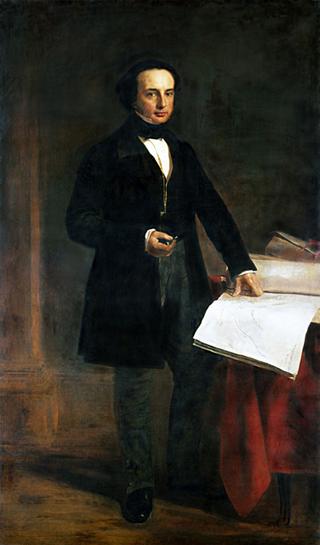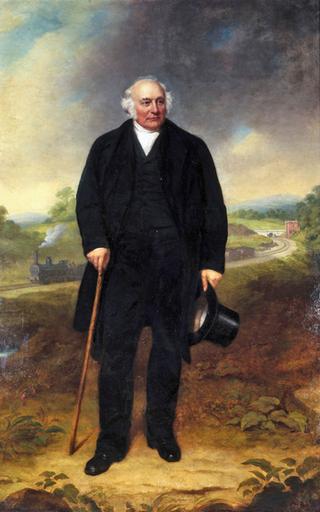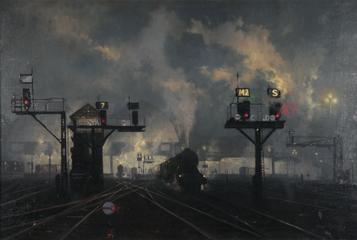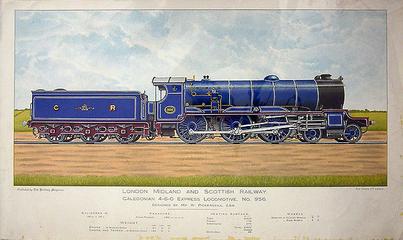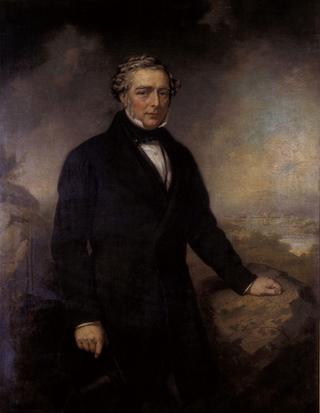
Watercolour of a Mughal bridge near Rajmahal, Jharkhand, India
- Made:
- 1857
- maker:
- George James Hervey Glinn

Painting, watercolour on paper, Mahomedan bridge near Rajmahal (Godhai) by Mr Glinn, 1857. Depicts a brick bridge in Mughal style, with trees in the background and mountains beyond. The title is inscribed in pencil on the paper below, over an identical inscription in pencil, together with the words "Mr Glinn fecit, 1857". The painting is from the collection of George Turnbull, Chief Engineer of the East Indian Railway. The inscriptions are in Turnbull’s hand.
The colonial railways are often understood as a British invention taken abroad to India. However, they also relied on existing Indian knowledge and technology. This bridge and others like it were crucial in Turnbull’s attempt to plot a route for the railway. The swamplands near Rajmahal made construction complicated. Turnbull followed existing roads, passing over old bridges as he went. He believed that this was the key to finding a viable route, because ‘where they [Indian people in the past] could make a road we could make a railway.’
The old bridges were usually blanketed in overgrown vegetation. But ‘one or two near Rajmahal’ were not. The detailed Mughal designs of these bridges was fully visible. This watercolour painting documents one of these bridges.
The painting’s artist, George James Hervey Glinn, was an Assistant Engineer working on the East Indian Railway at Rajmahal. After four years’ work he was promoted to the grade of Resident Engineer, remaining so until 1863.
People in the nineteenth century said Mahomedan, while we now say Muslim or Islamic. Mahomedan has become an archaic term and is considered by some Muslims to be offensive because it centralises humans, rather than Allah, in the religion.
Scottish engineer George Turnbull (1809-1889) oversaw the creation of one of the first railways in India, the East Indian Railway (EIR). The EIR ran from near Calcutta (now Kolkata), an East India Company trading post in the north-east that the Company established as the capital from 1773. The terminus was originally Benares (now Varanasi), but the line quickly extended to New Delhi in the north, which became the capital of India in 1911. Calcutta and New Delhi are over 1,300km miles from each other – further than the distance between Paris, France and Budapest, Hungary.
Turnbull collected artworks during his time in India, many of which were produced by EIR engineers. These watercolours and drawings provide a rare view of nineteenth-century India from the perspective of the British engineers designing and building the country’s first railways. The collection includes landscape scenes and portraits. While many of the landscapes show the construction of the railway, others focus entirely on India’s local architecture or its rural spaces. The portraits are of people Turnbull encountered while in India. While the portraits of British people are inscribed with their names, most of the Indian people depicted remain anonymous or identified only by their job.
The British introduced railways in India to satisfy the mounting economic and military needs of their colonial administration. They hoped that the new technology would foster an increased sense of collective identity by making it easier to travel quickly between distant regions. They also hoped the railways would socially ‘improve India’ by instilling a sense of punctuality among Indians, a quality British colonialists believed Indians lacked. The racist stereotypes underpinning these intentions, and the interconnected idea that technology could trigger social change, were common beliefs in nineteenth-century British society.
(Quotes in the above taken from George Turnbull’s autobiography.)
Details
- Category:
- Pictorial Collection (Railway)
- Object Number:
- 2017-7091
- Materials:
- graphite, paper (fibre product) and watercolour (paint)
- type:
- painting, watercolour
